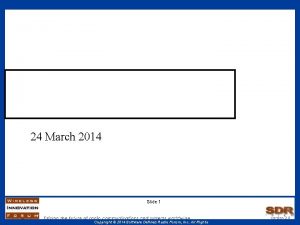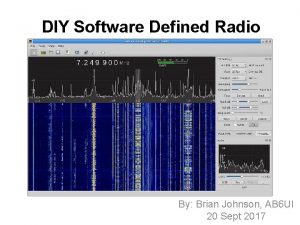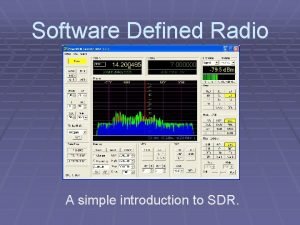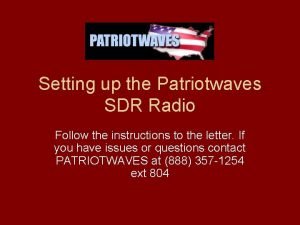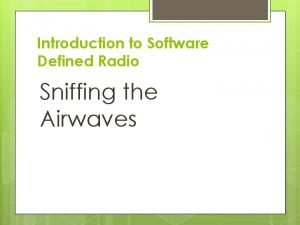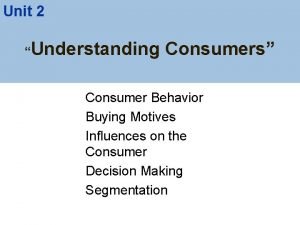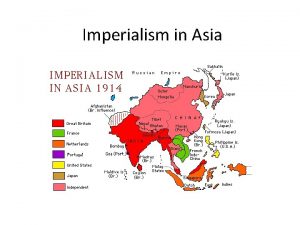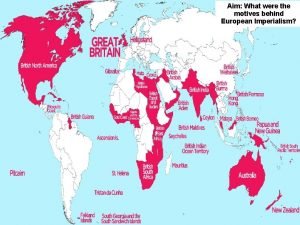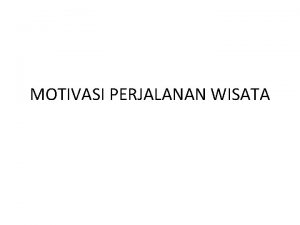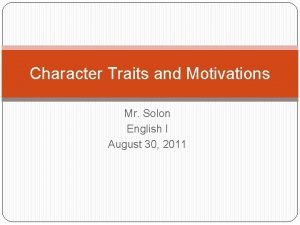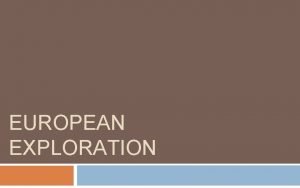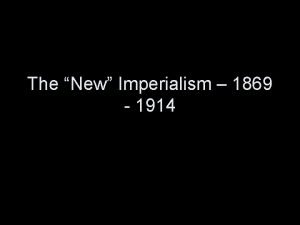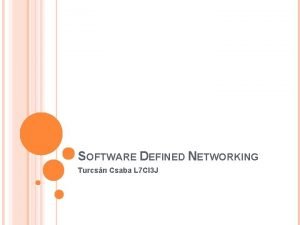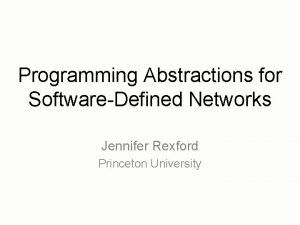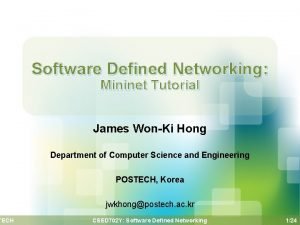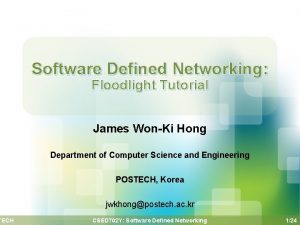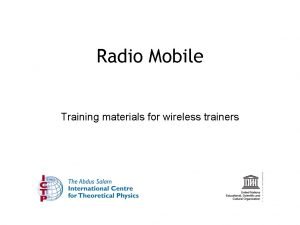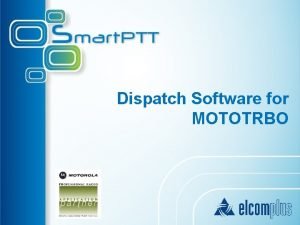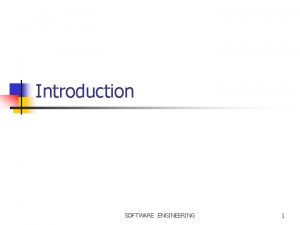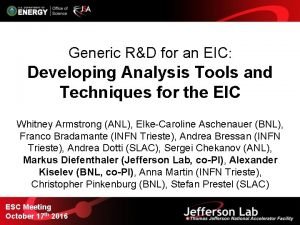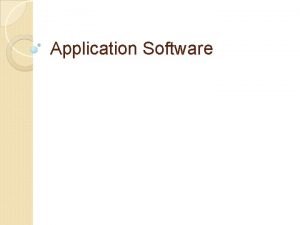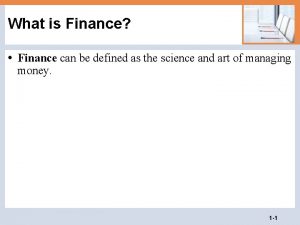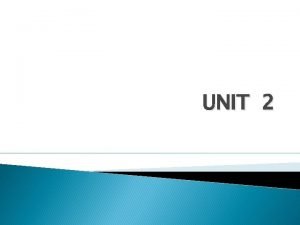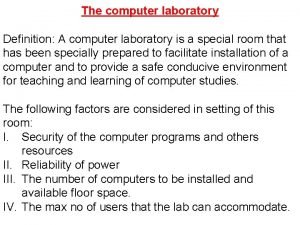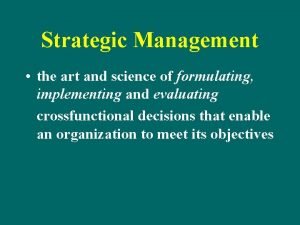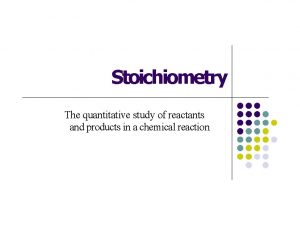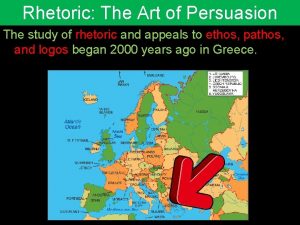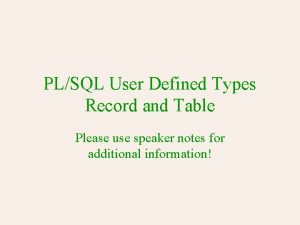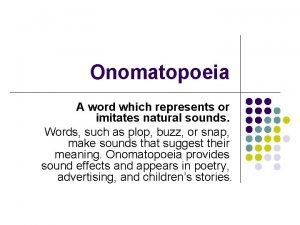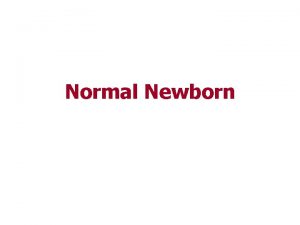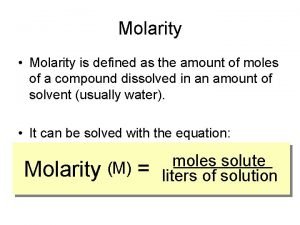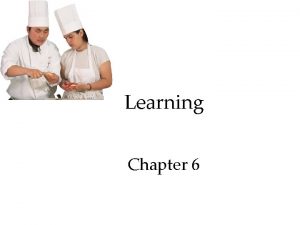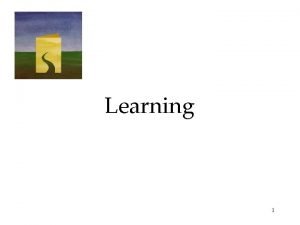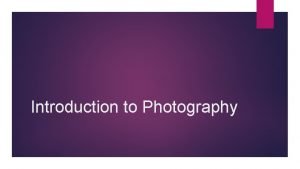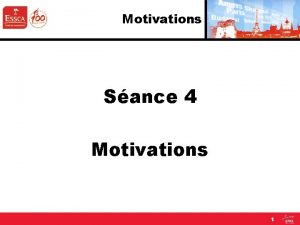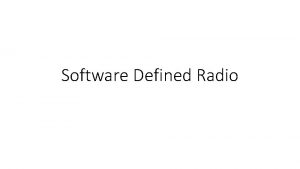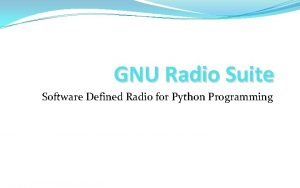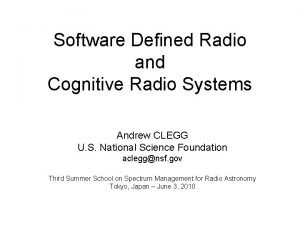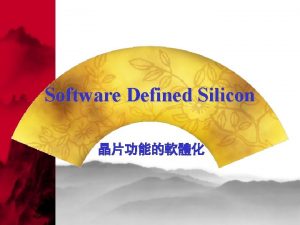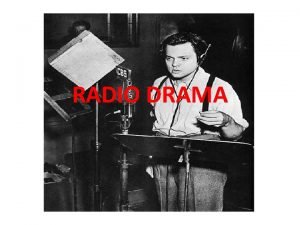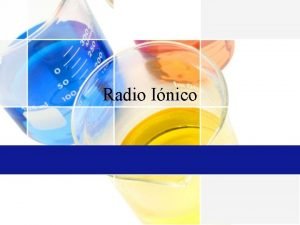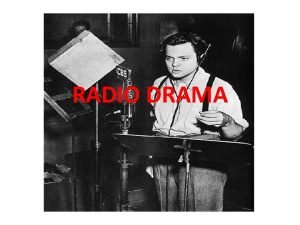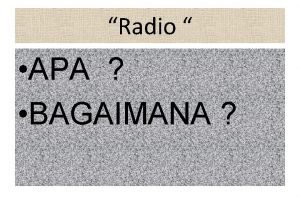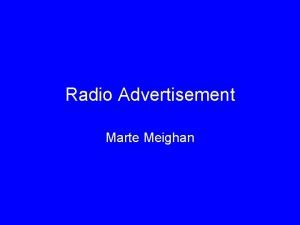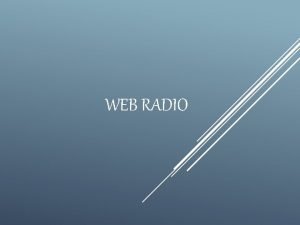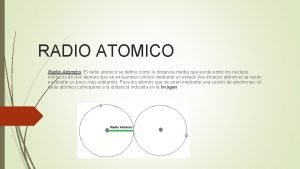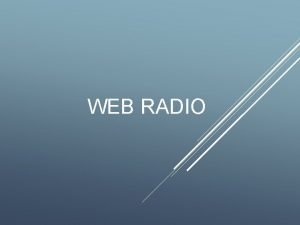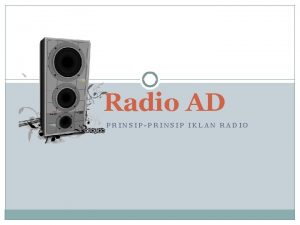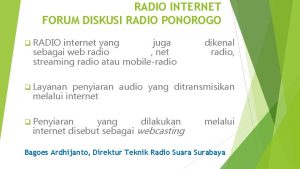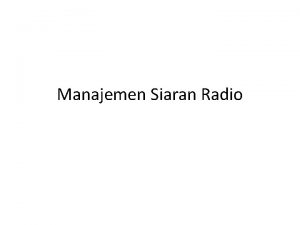Software Defined Radio Lecture 31 1 Motivations n




































































- Slides: 68

Software Defined Radio Lecture 31

1

Motivations n n n n Quad-band GSM GPS Bluetooth 802. 11 b…. GPRS EDGE WCDMA LTE 2

Motivations First-responder communications failures n SDR will facilitate radio interoperability n 3

Motivations: Efficient and Effective Frequency Allocation Courtesy: http: //www. ntia. doc. gov/ 4

Motivations: User’s Dream Office WLAN 802. 11 Public hot-spot 802. 11 DVB-H DAB ? Tomorrow’s new standard Higher Rate Cellular Mobile Fixed wireless access 802. 16 5

Motivation: Universal Handset 6

Motivation: Basestation Manufacturers 7

Motivations: Network Operators 8

Motivation: Deep Space Communications 9

Motivation: Subscribers, Services and Developers International roaming n Increased personalization and choice n Required Improved and more flexible services n Distinct services and the service logic n Unified communication n 10

Motivation: Standardization ISO OSI 7 -layer model Application Presentation Session Transport Network Logical Link Control Data Link Medium Access (MAC) Physical IEEE 802 standards Physical (PHY) 11

Motivation: Silicon capability n Performance/sampling tradeoff n Myriad standards exist for terrestrial communications n Resource requirement for communication system’s proof of the concept n Business logic and time to market n 12

Motivation: Commercial wireless communication industry is currently facing problems due to constant evolution of link-layer protocol standards (2. 5 G, 3 G, and 4 G) n Existence of incompatible wireless network technologies in different countries inhibiting deployment of global roaming facilities n Problems in rolling-out new services/features due to wide-spread presence of legacy subscriber handsets n 13

Software Defined Radio (SDR) n n A Software Defined Radio (SDR) is a system where components that have been typically implemented in hardware (e. g. mixers, filters, amplifiers, modulators/demodulators, etc. ) are instead implemented by means of software on a personal computer or embedded system. Development of generic radio platforms that can be reconfigured ‘on-the-fly’, possibly by means of over-the -air downloads, to target multiple radio standards operating over a wide range of carrier frequencies 14

SDR Vision Allowing what ever type of communication is required, Where ever you are, and When ever you need it n A generic hardware that can be programmed to manage any radio standards n But it has yet to be realized by the end user in many markets n 15

SDR (Types) • • • Capable of covering substantial frequency range and of executing software to provide variety of modulation techniques, wide-band or narrow-band operation, communications security functions and meet waveform performance requirements of relevant legacy systems Capable of storing large number of waveforms or air interfaces, and of adding new ones by software download System software should be capable of applying new or replacement modules for added functionality or bug fixes without reloading entire set of software Separate antenna system followed by some wideband filtering, amplification, and down conversion prior to receive A/D-conversion The transmission chain provides reverse function of D/A-conversion, analog upconversion, filtering and amplification 16

SDR: Drivers n Key Players might be from Academia, Industry and Research. But Challenge, problem and/or difficulty always brings an opportunity. Manufacturers, Operator, Regulator Authorities, Standardization Bodies etc. all together from AIR triangle should be benefiting from this occasion n Gnu. Radio, OSSIE, Fun. Cube Dongle, RTL Dongle, SDR Forum, Ettus Research …. . n 17

SDR: Drivers The cellular industry n Wide area coverage. n Global roaming. n Mobile users at vehicular speeds. n Subscription-based. n Licensed bands. The wireless LAN industry n Local coverage. n No handoff or roaming. n Fixed users. n Revenue through equipment sales. n Unlicensed bands. The Wireless Internet 18

SDR: Drivers Future trends of mobile communications 19

Block Diagram of a Digital Radio System 20

Digital Radio System 21

SDR: Handset Evolution 22

SDR: Handset Evolution 23

SDR: Handset Evolution 24

SDR: Benefits n Ease of design ¨ n Ease of manufacture ¨ n Allows implementation of new receiver structures and signal processing techniques Fewer discrete components ¨ n SR can change modes by loading appropriate software into memory Use of advanced signal processing techniques ¨ n Digital hardware reduces costs associated with manufacturing and testing radios Multimode operation ¨ n Reduces design-cycle time, quicker iterations Digital processors can implement functions such as synchronization, demodulation, error correction, decryption, etc. Flexibility to incorporate additional functionality ¨ Can be modified in the field to correct problems and to upgrade 25

SDR: Advantages n Flexible/reconfigurable ¨ n Reduced obsolescence ¨ n n Multiband/multimode Ubiquitous connectivity ¨ n Reprogrammable units and infrastructure Different standards can co-exist Enhances/facilitates experimentation Brings analog and digital worlds together Full convergence of digital networks and radio science ¨ Networkable ¨ Simultaneous voice, data, and video ¨ 26

SDR: Facilitators Antennas n Waveforms n Analog-to-Digital Converters (ADCs, DACs) n Digital Signal Processing n Amplifiers n Batteries n Cognition, behaviors n Design tools n 27

SDR: Issues Wideband radio circuits (Rx): high requirements n High requirements on A/D converter n Wideband PA (Tx): linearity, bandwidth, efficiency n Higher power consumption than dedicated ASIC approach n More MIPS required n Higher cost (today) n 28

SDR: Projects GNU Radio n OSSIE n Open. BSC n USRP n High Performance SDR n. O n Cisco + Open. Flow + Open. Stack = Software Defined Network (SDN) n 29

Software Defined Networking (SDN A technology to networking that allows centralized, programmable control planes so that network operators can control and manage directly their own virtualized networks n Separation of control and data planes, n Centralized, programmable control planes of network equipment, and n Support of multiple, isolated virtual networks n 30

SDN Tight coupling of data and control planes Control and data planes detached and separated Distributed control of equipment Programmable centralized control of equipments Single network (physically) Multiple, isolated and virtualized networks Current technique/methodology SDN 31

Software Defined Radio

Ideal SDR 33

Typical SDR 34

USRP 35

USRP in the context of SDR n n USRPs are inexpensive, computer hosted hardware solutions for developing software radios through GNU radio. Two USRP generations (USRP -1 and -2) are available 36

USRP Block Diagram 37

FPGA Ethernet 38

GNURadio (Operations) Mathematical operations (add, multiply, log, etc. ) n Interleaving, delay blocks, etc. n Filters (FIR, IIR, Hilbert, etc. ) n FFT blocks n Automatic Gain Control (AGC) blocks n Modulation and demodulation (FM, AM, PSK, QAM, GMSK, OFDM, etc. ) n Interpolation and decimation n Trellis and Viterbi support n 39

GNURadio(Sources/Sinks) n n n n Signal generators Noise generators Pseudo random number generators USRP source and sink (to transmit/receive signals via USRP) Graphical sinks (Oscilloscope, FFT, etc. ) Audio source and sink File source and sink (reads/writes samples from/to a file) User Datagram Protocol (UDP) source and sink (to transport samples over a network) 40

GNURadio (Implementation) Python Flow Graph (Functions Binder) SWIG (Sequencing and Scheduling ) C++ Signal Processing Blocks Giga Speed Ethernet/USB 2 connection USRP 1/2 41

SDR and USRP Integration n Hardware Used ¨ USRP N 200 ¨ WBX Daughterboard for GSM Quad-band Support ¨ 900 MHZ Antennas n Software Used GNURadio ¨ Open. BTS ¨ Asterisk ¨ Smqueue ¨ 42

SDR and USRP Integration 43

GSM vs Open. BTS is a software-based GSM access point (stack), allowing standard GSM-compatible mobile phones to make phone calls without depending on existing telecommunication providers' networks. Open. BTS software code plays the role of the MSC and the Visitor Location Register (VLR) in processing all the calls incoming to, or originating from subscribers visiting the given switch area. Open FUNCTIONS GSM BTS Control Functions MSC Asterisk Radio Management BSC GNU Radio Signaling Functions BTS USRP 44

Setting up the environment 45

Setting up the environment: Compatibility Issues n SIM Card Configuration SIM is a tool kit that stores certain parameters (i. e. IMSI, PLMN) within it to identify the correct network and to camp on it. To make the test phone camp on Open. BTS the parameters stored in the SIM card must be matched to the parameters in the configuration file of Open. BTS. n Clocking Issue Frequency accuracy is one the main issue in camping the handsets to the network. The BTS uses a single frequency source of absolute accuracy better than 0. 05 ppm for both RF frequency generation and synchronization. Stock USRP has a frequency accuracy of 20 ppm. 46

IMSI Catcher Commercial carrier SIM cards come with a preferred network list and to ensure the handset will scan Open. BTS network, it must be set up as the first preferred network. n Alternatively, the handsets can be forced to register on the test GSM network by going into the handset general network settings options and select an operator manually. n 47

Setting up the environment Clocking Issue n Solution We found that providing external clock to the USRP kit may be one of the solutions by which we can camp our mobile in Open. BTS. This external clock should be 52 MHz. 48

Setting up the environment Clock. Tamer Circuit 49

Setting up the environment Function Generator As External Clock source 50

Setting up the environment Testing 51

Other Applications AM/FM radio transmission and reception. n Radar Interception. n Spectrum Analyzer n GSM Interception n Channel Estimation n Reception of TV signals n 52

Low Cost SDR 53

$ 20 SDR (RTL Dongle) 54

$ 20 SDR (How it works) Input from an antenna is down sampled, filtered by The E 4000 tunerchip and passed to an analog to digital converter (RTL 2832 U) the output is then sent to the computer by USB. n All filtering, demodulation and other processing is done by the computer. n Audible output is then played back on the computer speakers n 55

-Session Border Controller -Performs NAT/PAT translation -Handles ressources related CAC -Analyzes SIP/SDP Routing Switching -Call Server -Handles registration, user profile and service management. -Performs profile related CAC -Acts as Policy Enforcement Point(PEP) 56

-We have introduced Policy Server (PS) -Decision Engine within PS provides dynamic/efficient control and management While taking into account dynamic and static info Routing Switching 57

Multi Criteria Decision Making (MCDM) and the Decision Engine n Several Criteria Link Profiles ¨ User Profiles ¨ Business Objectives ¨ Attributes extracted from the context differ at service and link level. ¨ n A Multi-criteria, Multi-Attribute and Multi. The Criteria may contain Sub-Criteria objective problem has to be addressed. 58

TOPSIS MCDM Method Application n n Figuring out the Goals, Criteria, And Alternatives. Goals, Criteria, Sub Criteria and Alternatives Hierarchy Construction. Decision Matrix on the basis of the underlying Goals, Criteria, Sub-Criteria and Alternatives Hierarchy. Utility Functions Building for the underlying method Mathematical Step are gone through in order to rank/grade the links. 59

TOPSIS MCDM Method Application 60

TOPSIS MCDM Method Application R Value Rank ¢ L 1 L 2 L 3 L 4 0. 3790 0. 3725 0. 8003 0. 3692 2 0. 3547 3 0. 4875 2 3 0. 3567 2 0. 4732 3 1 Iteration 1 4 1 — 2 — 0. 4725 3 0. 8996 — 4 3 This Inconsistency is overcome by integrating TOPSIS with Analytical Hierarchy Process (AHP) 61

TOPSIS and AHP Integration Relative Importance of Corresponding Elements in a Class Equally Important Saaty’s Scale 1 Moderately Important 3 Strongly Important 5 Very Strongly Important 7 Extremely Important 9 Intermediate Values Reciprocal Values 2, 4, 6, 8 1/2, 1/3, . , 1/9 62

Horizontal Handover Using the Same Decision Engine 63

Demo and GSM Traffic Capture 64

Applications: Open. BTS+Gnu Radio+USRP A GSM solution for disaster-recovery management and control while supporting communications with mobility and dynamicity support in addition to location tagging. An individual while carrying the boxed equipment to the spot can deploy the system to uplift the inter/intra communication. n Cell-Phone detection in the debris n 65

Applications: Open. BTS+Gnu. Radio+USRP Entrepreneurs mostly emphasize their businesses and infrastructures in settled and developed areas. n Low cost, low power, reconfigurable and flexible communication model for those Entrepreneurs ROI (Return on Investment) for MNO's (Mobile Network Operators) n GSM to Voice over IP (GSM-2 -Vo. IP), GSM to Conventional Telephony (GSM-2 -CT) n Security Applications (Jammers) 66 n

n n n n Conclusions Software Defined Radio is more than just an implementation in a software solution. AIR triangle must go hand in hand The true potentials of SDR has not been exploited Civil applications should surpass the Military activities Time to market products Design efficient and effective solutions Above all the concepts, techniques and technologies during the course can be realized by deploying SDR 67
 Software defined radio forum
Software defined radio forum Diy software defined radio
Diy software defined radio Softrock ensemble ii rx
Softrock ensemble ii rx Hdsdr zadig
Hdsdr zadig Sdr radio
Sdr radio This is a collection of well-defined objects
This is a collection of well-defined objects Buying motivations
Buying motivations Asian imperialism
Asian imperialism Motivations for imperialism in asia
Motivations for imperialism in asia 5 motivasi perjalanan wisata
5 motivasi perjalanan wisata Character traits and motivations
Character traits and motivations Samuel de champlain motivations
Samuel de champlain motivations John cabot css
John cabot css “god, glory, gold”
“god, glory, gold” Motives for imperialism
Motives for imperialism Three gs
Three gs English motivations for settlement
English motivations for settlement 01:640:244 lecture notes - lecture 15: plat, idah, farad
01:640:244 lecture notes - lecture 15: plat, idah, farad Trunking vs conventional radio system
Trunking vs conventional radio system 7 ci
7 ci Three dumb routers
Three dumb routers Abstractions for software defined networks
Abstractions for software defined networks Data plane control plane and management plane
Data plane control plane and management plane Http://compitv.info:8080
Http://compitv.info:8080 Floodlight controller installation
Floodlight controller installation Python event manager
Python event manager Software engineering lecture notes
Software engineering lecture notes Software project management notes
Software project management notes Lecture presentation software
Lecture presentation software Radio mobile software
Radio mobile software Radio dispatch software
Radio dispatch software Software maintenance in software engineering ppt
Software maintenance in software engineering ppt What is software implementation in software engineering
What is software implementation in software engineering Modern software technologies
Modern software technologies Software engineering vs computer science
Software engineering vs computer science Metrics computer science
Metrics computer science Skills and applications chapter 3
Skills and applications chapter 3 Difference between generic software and custom software
Difference between generic software and custom software Difference between student software and industrial software
Difference between student software and industrial software Software crisis of 1960s
Software crisis of 1960s Examples of product metrics
Examples of product metrics Is an os system software or application software
Is an os system software or application software Eic software software review
Eic software software review Real time software design in software engineering
Real time software design in software engineering Design principles in software engineering
Design principles in software engineering Multimedia software applications
Multimedia software applications Piecewise in real life situation
Piecewise in real life situation Energy physics definition
Energy physics definition Finance
Finance Fattom definition
Fattom definition Usability quality attribute that assesses
Usability quality attribute that assesses Conflict can be defined as:
Conflict can be defined as: Ambiguously defined triangle
Ambiguously defined triangle Relationship between maturation and learning
Relationship between maturation and learning Rotter mischel
Rotter mischel Laboratory method
Laboratory method The art and science of formulating
The art and science of formulating Stoichiometry is defined as the quantitative study of
Stoichiometry is defined as the quantitative study of Stoichiometry is defined as the quantitative study of
Stoichiometry is defined as the quantitative study of Which greek philosopher defined the art of persuasion
Which greek philosopher defined the art of persuasion Sql user defined table
Sql user defined table Terrestrial biomes definition
Terrestrial biomes definition Onomatopoeia in sentences
Onomatopoeia in sentences Neonatal period is defined as
Neonatal period is defined as Molarity is defined as the
Molarity is defined as the Light may be defined as
Light may be defined as Learning is defined as
Learning is defined as Relatively permanent means
Relatively permanent means Meaning of photography
Meaning of photography
